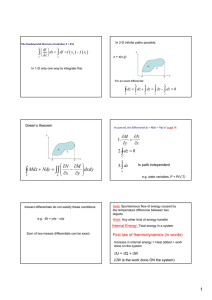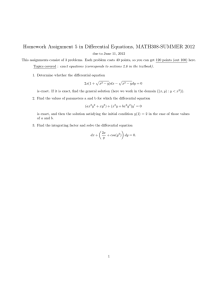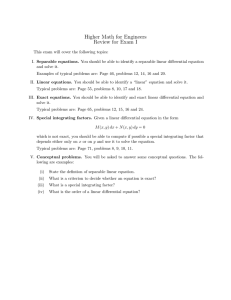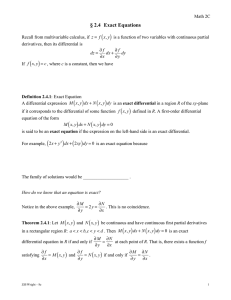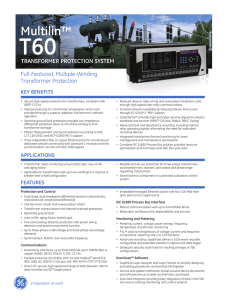PHYSICS 140A : ASSIGNMENT #1 SOLUTIONS Problem 1. (a)
advertisement
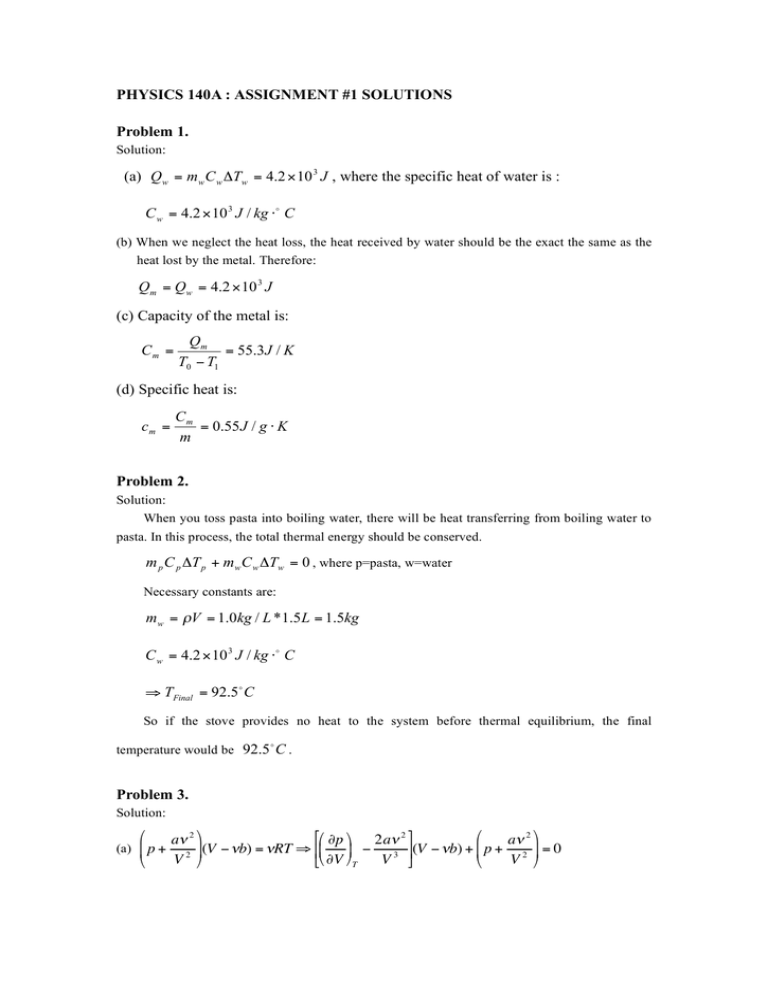
PHYSICS 140A : ASSIGNMENT #1 SOLUTIONS Problem 1. Solution: (a) Qw = m w C w "Tw = 4.2 ! 10 3 J , where the specific heat of water is : C w = 4.2 " 10 3 J / kg !o C (b) When we neglect the heat loss, the heat received by water should be the exact the same as the heat lost by the metal. Therefore: Qm = Qw = 4.2 ! 10 3 J (c) Capacity of the metal is: Cm = Qm = 55.3 J / K T0 ! T1 (d) Specific heat is: cm = Cm = 0.55 J / g ! K m Problem 2. Solution: When you toss pasta into boiling water, there will be heat transferring from boiling water to pasta. In this process, the total thermal energy should be conserved. m p C p !T p + m w C w !Tw = 0 , where p=pasta, w=water Necessary constants are: m w = !V = 1.0kg / L * 1.5 L = 1.5kg C w = 4.2 " 10 3 J / kg !o C ! TFinal = 92.5 o C So if the stove provides no heat to the system before thermal equilibrium, the final o temperature would be 92.5 C . Problem 3. Solution: # (a) % p + $ ! $ ,$ #p ' 2a+ 2 / a" 2 & a+ 2 ' (V ) " b) = " RT " * (V * + b) + p + & ) ( & )=0 . 1 V2 ' V3 0 V2 ( -% #V (T % ! $ #p ' +RT 2a+ 2 "& ) =* + % #V (T (V * +b) 2 V3 uRT 2a ' (p $ ) !V % ! 2 " = 2 u & (V #T (u ! b) ! # (b) % p + $ $ #p ' a" 2 & (V ) "b) = "RT " & ) (V * +b) = +R 2 ( % #T (V V ' $ #p ' R "& ) = % #T (V (u * b) ! ! # (c) % p + $ & a" 2 & 2a$ 2 & %V ) a$ 2 )& %V ) (V ) " b) = " RT " # (V # $ b) + p + ( + ( ( +( + = $R V2 ' V 3 ' %T * p V 2 *' %T * p ' ! ! 2a$ 2 & %V ) $RT & %V ) " # 3 ( + (V # $b) + ( + = $R V ' %T * p V # $b ' %T * p ! " ! where u = 1 $ #V ' R & ) = V % #T ( p 2ab * 2a + RTu u2 u u*b V is the molar volume. v ! Problem 4. ! Solution: # "E & ( + $ "T ' p (a) C p = % ! cp = ! # "V & )* p% ( = 0 eT /T0 + )R $ "T ' p T0 " 0 T / T0 e +R T0 # "V & ( can be obtained by the similar method employed in Problem 3. $ "T ' p The term p% TB (b) Q = ! # "c TA TB p dT = % "$0 # '& T TA 0 ( eT /T0 + "R*dT = E(TB ,V," ) + E(TA ,V," ) + "R(TB + TA ) ) = 3.58 !10 4 J ! 2 $ "p ' , ! is density defined by M /V = M 0 /u , M 0 is molar mass. ) % "# ( dQ= 0 (c) c s = & ! ! c s2 = "p "u u 2 % "p ( =$ ' * "u "# M 0 & "u ) dQ= 0 (1) Therefore, in order to compute c s , we must know the relationship between p and v. ! dE = dQ ! pdV = ! pdV , also we know: E = !" 0 e T / T0 " dT = # pT0 #T /T0 e du $0 (2) From equation of state, (u " b)dp + pdu = RdT , then substituating (2) into this expression, we get: ! dp = " ! RT $ RT0 "T /T0 ' e &1+ )du (u " b) 2 % #0 ( (3) Then from (1) we can get the complete solution: c s2 = ! 2 RT # u & # RT0 "T /T0 & e % ( %1+ ( M0 $ u " b ' $ )0 ' Problem 5. ! Solution: (a) Travel time is not a state function because it depends on the path taken and not on the endpoints alone. (b) Elevation is a state function. No matter what path you take between A and B, the net elevation change will be the same. © Aggravation most certainly is not a state function. You can become more aggravated if your path takes you along a highly congested stretch of road. Problem 6. Solution: For a differential as: dW = ! A dx i i i A simple rule to identify it “exact” or “inexact” is: !Ai !A j = !x j !xi (1) dW = 2 x 2 ydx + x 3 dy Q !Ay !Ax = 2 x 2 " 3x 2 = !y !x ! Inexact differential. It is easy to find if we employ a factor “ 1 ”, the new differential becomes: x dU = 2 xydx + x 2 dy = d ( x 2 y ) Now it is an exact differental. L = ln x (2) dW = y2z x2 z xy dx + dy + dz 2 2 x+ y ( x + y) ( x + y) According to the rule above, it is an exact differential. " xyz % ' # x + y& In fact, it can be written as dW = d$ (3) x dW = e xy dx + (2 x + e xy )dy y ! Obviously, it is an inexact differential.
